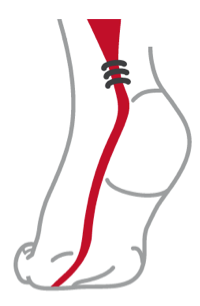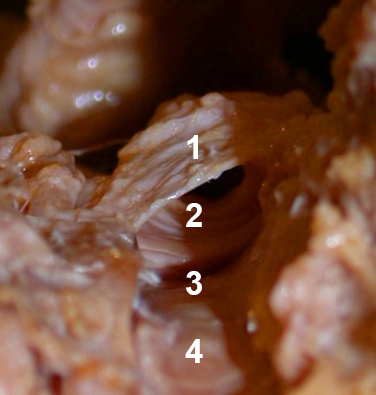Functional Hallux Limitus or Functional Hallux Rigidus is due to a blockage in the free sliding tendon of the big toe’s Flexor Hallucis Longus (FHL). The blockage occurs in the retro-talar tunnel where the tendon becomes entangled when walking and can no longer slide freely. The conflict is observed at the end of the support phase just before the propulsion forward when the ankle is positioned in dorsiflexion.

The big toe’s flexor digitorum longus muscle originates in the deep posterior section of the leg and exerts itself on the distal phalanx of the big toe. The muscular-tendinous junction of the FHL is located just above the retro-talar tunnel.
This tunnel is formed :
- forward by a trochlear bony groove hollowed out in the talus by the tendon which, at this point, changes direction at a right angle to take the big toe parallel to the sole of the foot.
- behind by a fibrous retinacula pulley, structurally similar to a deep flexor pulley of the hand.
 Retro-talar tunnel (inferior view)
Retro-talar tunnel (inferior view)
1. Retro-talar pulley
2. Talus tubercle
3. Subtalar joint
4. Calcaneal tunnel
The anatomy of the tunnel is subject to significant variations as we have observed during our dissections and on more than 1500 endoscopic tenolysis:
- • At muscular level: The seat of the muscular-tendinous junction should sit more or less above or opposite the tunnel, but it will cause conflict if situated below. The same is true if the muscle is enlarged as is frequently seen in dancers and skaters.
- At bone level: The presence of a large posterior talar tubercle or an os trigonum may interfere with the tendon sliding freely.
- Pulley texture: It can be more or less stretchy depending on age or collagen content.
- At synovial level: An inflammatory state, as in the event of synovitis, can create an accordion effect which slows down the sliding.
- At tendon level: The presence of fraying or a tendon nodule with repeated micro-tears under the effect of the conflict.
Learn more
2013 FHL CONGRESS – FHL ANATOMY2013 FHL CONGRESS – FHL ANATOMY
Identification of the retrotalar pulley of the Flexor Hallucis Longus tendon
2016 FHL WORKSHOPS – ANATOMY WORKSHOP
 EN
EN  DE
DE  ES
ES  FR
FR 